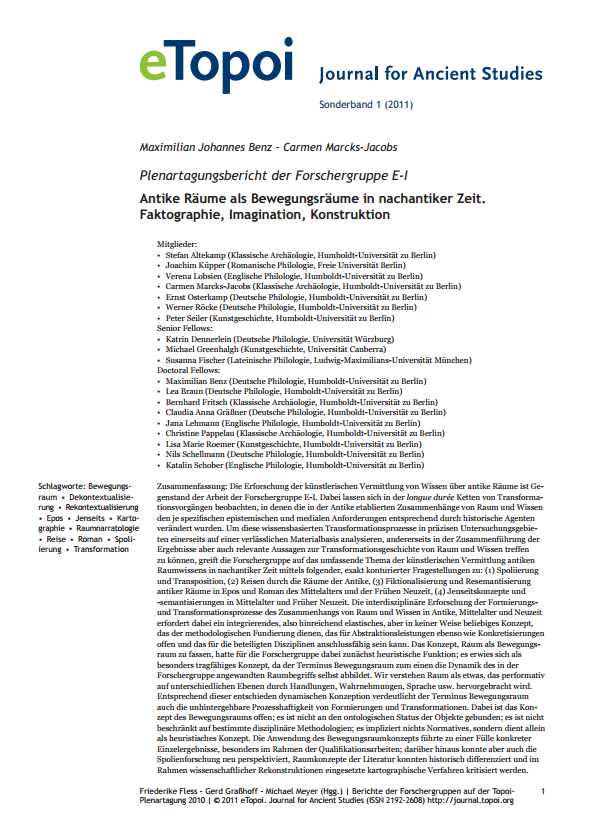Ancient Spaces as Spaces of Movement in the Postclassical Era: Factography, Imagination, Construction
The Research Group E-I investigates artistic forms of the transmission of knowledge concerning spaces of antiquity. In this respect long-term chains of transformative processes are to be observed through which the interrelationships between space and knowledge established in antiquity have been altered by historical agents through specific epistemic and medial claims. The aim is twofold: to analyze these knowledge-based processes of transformation in precise areas of investigation on a reliable material basis on the one hand; on the other to formulate relevant statements concerning the history of the transformation of space and knowledge through the consolidation of research results. For this reason, the research group takes up the all-encompassing topic of the artistic transmission of knowledge about space in the post-classical era in the context of the following precisely formulated contoured topic areas: (1) spoliation and transposition, (2) travels through spaces of antiquity, (3) the fictionalization and resemanticization of antique spaces in epics and novels of the Middle Ages and early modern period, (4) concepts and semanticizations of the Beyond in the Middle Ages and early modern period. Interdisciplinary research into the processes of formation and transformation of the interrelationships between space and knowledge in antiquity, the Middle Ages, and the modern period, however, calls for an integrative and sufficiently elastic concept, albeit one that is by no means arbitrary and which serves as a methodological foundation while remaining receptive to procedures of abstraction as well as of concretization, and which is adaptable to the participating disciplines. As for our research group, the concept of space as an area of movement has a heuristic function; it has proven to be an especially stable concept because the term space of movement pictures the dynamism of the concept of space which is applied by the group. We conceive of space as being generated performatively on a variety of levels through actions, perceptions, language, etc. In accordance with this emphatically dynamic conception, the term space of movement also clarifies the irreducible processual quality of formation and transformation. The concept of a space of movement remains open; it is not bound to the ontological status of the object, nor is it restricted to specific disciplinary methodologies; it implies nothing normative, but serves instead as an exclusively heuristic concept. The application of the concept of the space of movement leads toward a multiplicity of concrete individual results, particularly in the framework of the qualifying projects; moreover, it has proven possible to provide research on spoliation with a new perspective, to differentiate concepts of space in literature in historical terms, and to criticize cartographic procedures in the framework of scientific reconstructions.
Die Erforschung der künstlerischen Vermittlung von Wissen über antike Räume ist Gegenstand der Arbeit der Forschergruppe E-I. Dabei lassen sich in der longue durée Ketten von Transformationsvorgängen beobachten, in denen die in der Antike etablierten Zusammenhänge von Raum und Wissen den je spezifischen epistemischen und medialen Anforderungen entsprechend durch historische Agenten verändert wurden. Um diese wissensbasierten Transformationsprozesse in präzisen Untersuchungsgebieten einerseits auf einer verlässlichen Materialbasis analysieren, andererseits in der Zusammenführung der Ergebnisse aber auch relevante Aussagen zur Transformationsgeschichte von Raum und Wissen treffen zu können, greift die Forschergruppe auf das umfassende Thema der künstlerischen Vermittlung antiken Raumwissens in nachantiker Zeit mittels folgender, exakt konturierter Fragestellungen zu: (1) Spoliierung und Transposition, (2) Reisen durch die Räume der Antike, (3) Fiktionalisierung und Resemantisierung antiker Räume in Epos und Roman des Mittelalters und der Frühen Neuzeit, (4) Jenseitskonzepte und -semantisierungen in Mittelalter und Früher Neuzeit. Die interdisziplinäre Erforschung der Formierungs- und Transformationsprozesse des Zusammenhangs von Raum und Wissen in Antike, Mittelalter und Neuzeit erfordert dabei ein integrierendes, also hinreichend elastisches, aber in keiner Weise beliebiges Konzept, das der methodologischen Fundierung dienen, das für Abstraktionsleistungen ebenso wie Konkretisierungen offen und das für die beteiligten Disziplinen anschlussfähig sein kann. Das Konzept, Raum als Bewegungsraum zu fassen, hatte für die Forschergruppe dabei zunächst heuristische Funktion; es erwies sich als besonders tragfähiges Konzept, da der Terminus Bewegungsraum zum einen die Dynamik des in der Forschergruppe angewandten Raumbegriffs selbst abbildet. Wir verstehen Raum als etwas, das performativ auf unterschiedlichen Ebenen durch Handlungen, Wahrnehmungen, Sprache usw. hervorgebracht wird. Entsprechend dieser entschieden dynamischen Konzeption verdeutlicht der Terminus Bewegungsraum auch die unhintergehbare Prozesshaftigkeit von Formierungen und Transformationen. Dabei ist das Konzept des Bewegungsraums offen; es ist nicht an den ontologischen Status der Objekte gebunden; es ist nicht beschränkt auf bestimmte disziplinäre Methodologien; es impliziert nichts Normatives, sondern dient allein als heuristisches Konzept. Die Anwendung des Bewegungsraumkonzepts führte zu einer Fülle konkreter Einzelergebnisse, besonders im Rahmen der Qualifikationsarbeiten; darüber hinaus konnte aber auch die Spolienforschung neu perspektiviert, Raumkonzepte der Literatur konnten historisch differenziert und im Rahmen wissenschaftlicher Rekonstruktionen eingesetzte kartographische Verfahren kritisiert werden.

